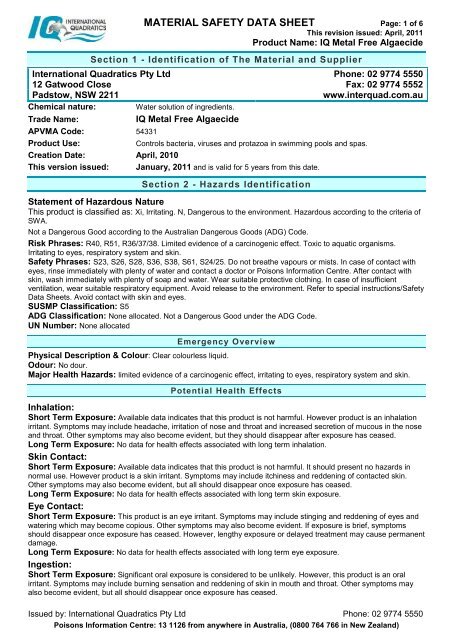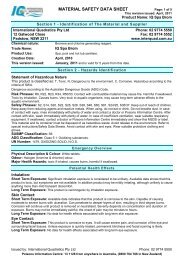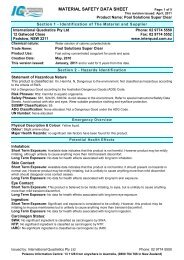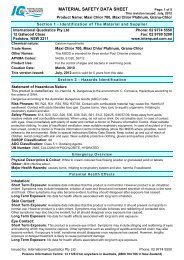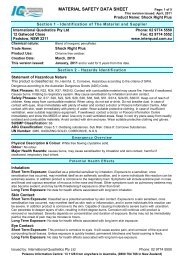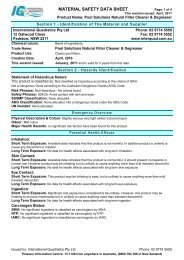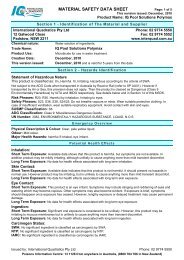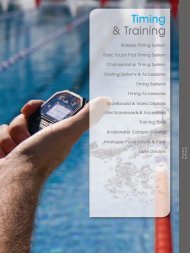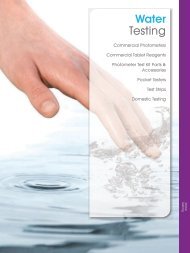IQ Pool Solutions Metal Free Algaecide
IQ Pool Solutions Metal Free Algaecide
IQ Pool Solutions Metal Free Algaecide
You also want an ePaper? Increase the reach of your titles
YUMPU automatically turns print PDFs into web optimized ePapers that Google loves.
MATERIAL SAFETY DATA SHEET Page: 1 of 6This revision issued: April, 2011Product Name: <strong>IQ</strong> <strong>Metal</strong> <strong>Free</strong> <strong>Algaecide</strong>Section 1 - Identification of The Material and SupplierInternational Quadratics Pty Ltd Phone: 02 9774 555012 Gatwood Close Fax: 02 9774 5552Padstow, NSW 2211www.interquad.com.auChemical nature:Water solution of ingredients.Trade Name:<strong>IQ</strong> <strong>Metal</strong> <strong>Free</strong> <strong>Algaecide</strong>APVMA Code: 54331Product Use:Controls bacteria, viruses and protazoa in swimming pools and spas.Creation Date: April, 2010This version issued: January, 2011 and is valid for 5 years from this date.Section 2 - Hazards IdentificationStatement of Hazardous NatureThis product is classified as: Xi, Irritating. N, Dangerous to the environment. Hazardous according to the criteria ofSWA.Not a Dangerous Good according to the Australian Dangerous Goods (ADG) Code.Risk Phrases: R40, R51, R36/37/38. Limited evidence of a carcinogenic effect. Toxic to aquatic organisms.Irritating to eyes, respiratory system and skin.Safety Phrases: S23, S26, S28, S36, S38, S61, S24/25. Do not breathe vapours or mists. In case of contact witheyes, rinse immediately with plenty of water and contact a doctor or Poisons Information Centre. After contact withskin, wash immediately with plenty of soap and water. Wear suitable protective clothing. In case of insufficientventilation, wear suitable respiratory equipment. Avoid release to the environment. Refer to special instructions/SafetyData Sheets. Avoid contact with skin and eyes.SUSMP Classification: S5ADG Classification: None allocated. Not a Dangerous Good under the ADG Code.UN Number: None allocatedEmergency OverviewPhysical Description & Colour: Clear colourless liquid.Odour: No dour.Major Health Hazards: limited evidence of a carcinogenic effect, irritating to eyes, respiratory system and skin.Potential Health EffectsInhalation:Short Term Exposure: Available data indicates that this product is not harmful. However product is an inhalationirritant. Symptoms may include headache, irritation of nose and throat and increased secretion of mucous in the noseand throat. Other symptoms may also become evident, but they should disappear after exposure has ceased.Long Term Exposure: No data for health effects associated with long term inhalation.Skin Contact:Short Term Exposure: Available data indicates that this product is not harmful. It should present no hazards innormal use. However product is a skin irritant. Symptoms may include itchiness and reddening of contacted skin.Other symptoms may also become evident, but all should disappear once exposure has ceased.Long Term Exposure: No data for health effects associated with long term skin exposure.Eye Contact:Short Term Exposure: This product is an eye irritant. Symptoms may include stinging and reddening of eyes andwatering which may become copious. Other symptoms may also become evident. If exposure is brief, symptomsshould disappear once exposure has ceased. However, lengthy exposure or delayed treatment may cause permanentdamage.Long Term Exposure: No data for health effects associated with long term eye exposure.Ingestion:Short Term Exposure: Significant oral exposure is considered to be unlikely. However, this product is an oralirritant. Symptoms may include burning sensation and reddening of skin in mouth and throat. Other symptoms mayalso become evident, but all should disappear once exposure has ceased.Issued by: International Quadratics Pty Ltd Phone: 02 9774 5550Poisons Information Centre: 13 1126 from anywhere in Australia, (0800 764 766 in New Zealand)
MATERIAL SAFETY DATA SHEET Page: 2 of 6This revision issued: April, 2011Product Name: <strong>IQ</strong> <strong>Metal</strong> <strong>Free</strong> <strong>Algaecide</strong>Long Term Exposure: No data for health effects associated with long term ingestion.Carcinogen Status:SWA: Simazine is classified by SWA as a Class 3 Carcinogen, possibly carcinogenic to humans.See the SWA website for further details. A web address has not been provided as addresses frequently change.NTP: No significant ingredient is classified as carcinogenic by NTP.IARC: Simazine is Class 3 - unclassifiable as to carcinogenicity to humans.See the IARC website for further details. A web address has not been provided as addresses frequently change.Section 3 - Composition/Information on IngredientsIngredients CAS No Conc,% TWA (mg/m 3 ) STEL (mg/m 3 )simazine 122-34-9 35g/L not set not setPoly(oxyethylene) (dimethylimino) ethylene (dimethylimino) ethylene dichloride31512-74-0 300g/L not set not setOther non hazardous ingredients secret to 100 not set not setThis is a commercial product whose exact ratio of components may vary slightly. Minor quantities of other nonhazardous ingredients are also possible.The SWA TWA exposure value is the average airborne concentration of a particular substance when calculated over a normal 8 hour working dayfor a 5 day working week. The STEL (Short Term Exposure Limit) is an exposure value that may be equalled (but should not be exceeded) for nolonger than 15 minutes and should not be repeated more than 4 times per day. There should be at least 60 minutes between successive exposuresat the STEL. The term "peak "is used when the TWA limit, because of the rapid action of the substance, should never be exceeded, even briefly.General Information:Section 4 - First Aid MeasuresYou should call The Poisons Information Centre if you feel that you may have been poisoned, burned or irritated bythis product. The number is 13 1126 from anywhere in Australia (0800 764 766 in New Zealand) and is available at alltimes. Have this MSDS with you when you call.Inhalation: If irritation occurs, contact a Poisons Information Centre, or call a doctor. Remove source ofcontamination or move victim to fresh air. If breathing is difficult, oxygen may be beneficial if administered by trainedpersonnel, preferably on a doctor's advice. In severe cases, symptoms of pulmonary oedema can be delayed up to 48hours after exposure.Skin Contact: Wash gently and thoroughly with warm water (use non-abrasive soap if necessary) for 10-20 minutesor until product is removed. Under running water, remove contaminated clothing, shoes and leather goods (e.g.watchbands and belts) and completely decontaminate them before reuse or discard. If irritation persists, repeatflushing and seek medical attention.Eye Contact: Immediately flush the contaminated eye(s) with lukewarm, gently flowing water for 20 minutes or untilthe product is removed, while holding the eyelid(s) open. Take care not to rinse contaminated water into theunaffected eye or onto the face. Obtain medical attention immediately. Take special care if exposed person is wearingcontact lenses.Ingestion: If swallowed, do NOT induce vomiting. Wash mouth with water and contact a Poisons InformationCentre, or call a doctor.Section 5 - Fire Fighting MeasuresFire and Explosion Hazards: There is no risk of an explosion from this product under normal circumstances if it isinvolved in a fire.Only small quantities of decomposition products are expected from this product at temperatures normally achieved ina fire. This will only occur after heating to dryness.Fire decomposition products from this product may be toxic if inhaled. Take appropriate protective measures.Extinguishing Media: Not Combustible. Use extinguishing media suited to burning materials.Fire Fighting: If a significant quantity of this product is involved in a fire, call the fire brigade.Flash point:Does not burn.Upper Flammability Limit: Does not burn.Lower Flammability Limit:Autoignition temperature:Flammability Class:Does not burn.Not applicable - does not burn.Does not burn.Issued by: International Quadratics Pty Ltd Phone: 02 9774 5550Poisons Information Centre: 13 1126 from anywhere in Australia, (0800 764 766 in New Zealand)
<strong>Free</strong>zing/Melting Point:Volatiles:Vapour Pressure:Vapour Density:Specific Gravity:Water Solubility:pH:Volatility:Odour Threshold:Evaporation Rate:Coeff Oil/water Distribution:Autoignition temp:MATERIAL SAFETY DATA SHEET Page: 4 of 6This revision issued: April, 2011Product Name: <strong>IQ</strong> <strong>Metal</strong> <strong>Free</strong> <strong>Algaecide</strong>Below 0°C.Water component.2.37 kPa at 20°C (water vapour pressure).No data.No data.Completely soluble in water.No data.No data.No data.No data.No dataNot applicable - does not burn.Section 10 - Stability and ReactivityReactivity: This product is unlikely to react or decompose under normal storage conditions. However, if you haveany doubts, contact the supplier for advice on shelf life properties.Conditions to Avoid: Protect this product from light. Store in the closed original container in a dry, cool, wellventilatedarea out of direct sunlight.Incompatibilities: strong oxidising agents, anionic surfactants.Fire Decomposition: Only small quantities of decomposition products are expected from this product attemperatures normally achieved in a fire. This will only occur after heating to dryness. Combustion forms carbondioxide, and if incomplete, carbon monoxide and smoke. Water is also formed. May form nitrogen and its compounds,and under some circumstances, oxides of nitrogen. Occasionally hydrogen cyanide gas in reducing atmospheres.May form hydrogen chloride gas, other compounds of chlorine. Carbon monoxide poisoning produces headache,weakness, nausea, dizziness, confusion, dimness of vision, disturbance of judgment, and unconsciousness followedby coma and death.Polymerisation: This product will not undergo polymerisation reactions.Section 11 - Toxicological InformationToxicity: An information profile for Simazine is available at http://extoxnet.orst.edu/pips/ghindex.htmlAcute toxicity: The reported oral LD 50 for technical Simazine in rats and mice is >5000 mg/kg; its dermal LD 50 is3100 mg/kg in rats and > 10,000 mg/kg in rabbits. The 4-hour inhalation LC 50 in rats is greater than 2 mg/L. Theformulated products, in most cases, are less toxic via all routes. Simazine is nonirritating to the skin and eyes ofrabbits except at high doses. Symptoms exhibited by poisoned sheep included lower food intake, higher water intake,incoordination, tremors, and weakness, especially in the hindquarters.Chronic toxicity: Some 90-day feeding studies showed reduced body weight at 67 to 100 mg/kg/day. This sameeffect and kidney toxicity were seen in rats at doses of 150 mg/kg/day. In 2-year chronic oral feeding studies in whichrats were given daily dosages of 5 mg/kg/day of Simazine in the diet, no gross or microscopic signs of toxicity wereseen. When rats were given repeated doses of 15 mg/kg/day, some liver cells degenerated during the first 3 days, butthe condition did not progress. Instead, the liver adapted and the compound was metabolized. Other effects observedin test animals include tremors, damage to the testes, kidneys, liver, and thyroid, disturbances in sperm production,and gene mutations.Reproductive effects: No adverse effects on reproductive capacity or development were observed in a threegenerationstudy of rats fed 5 mg/kg/day Simazine. Reproductive effects are not likely in humans under normalcircumstances.Teratogenic effects: No dose-related teratogenic effects were observed when rabbits were given daily doses of 5,75, or 200 mg/kg for days 7 through 19 of pregnancy. Simazine does not appear to be teratogenic.Mutagenic effects: Simazine has shown negative results in a variety of mutagenicity tests on bacterial cultures. It islikely that Simazine is either nonmutagenic or weakly mutagenic.Carcinogenic effects: Simazine was not tumorigenic in mice at the maximum tolerated dose of 215 mg/kg/day overan 18-month period. In other studies, doses as low as 5 mg/kg/day produced excess tumours (thyroid and mammary)in female rats. Because of inconsistencies in the data, it is not possible to determine Simazine's carcinogenic status.Organ toxicity: Damage to the testes, kidneys, liver, and thyroid has been observed in test animals.Fate in humans and animals: Studies in rats, goats, and sheep reveal that 60 to 70% of the ingested dose may beabsorbed into the system, with approximately 5 to 10% distributed systemically to tissues. The remainder iseliminated via urine within 24 hours. It has been reported that Simazine residues were present in the urine of sheepfor up to 12 days after administration of a single oral dose. The maximum concentration in the urine occurred from 2to 6 days after administration. There is no data to hand indicating any particular target organs.Issued by: International Quadratics Pty Ltd Phone: 02 9774 5550Poisons Information Centre: 13 1126 from anywhere in Australia, (0800 764 766 in New Zealand)
IngredientSimazineMATERIAL SAFETY DATA SHEET Page: 5 of 6This revision issued: April, 2011Product Name: <strong>IQ</strong> <strong>Metal</strong> <strong>Free</strong> <strong>Algaecide</strong>Classification of Hazardous IngredientsRisk PhrasesConc>=1%: Xn; R40Section 12 - Ecological InformationThis product is toxic to aquatic organisms. Insufficient data to be sure of status.Effects on birds: Simazine is practically nontoxic to birds. The reported LD 50 values in mallard and Japanese quailare >4600 mg/kg and 1785 mg/kg, respectively. Similar high values are reported for other species.Effects on aquatic organisms: Simazine is very toxic to aquatic organisms.Effects on other organisms: While many mammals may be insensitive to Simazine, sheep and cattle are especiallysensitive. Simazine is nontoxic to bees. A soil LC 50 in earthworms of >1000 mg/kg has been reported.Environmental Fate:Breakdown in soil and groundwater: Simazine is moderately persistent with an average field half-life of 60 days.Soil half-lives of 28-149 days have been reported. Residual activity may remain for a year after application (2 to 4kg/ha) in high pH soils. Simazine is moderately to poorly bound to soils. It does, however, adsorb to clays and mucks.Its low water solubility, however, makes it less mobile, limiting its leaching potential.Breakdown in water: The average half-life of Simazine in ponds where it has been applied is 30 days, with the actualhalf-life dependent on the level of algae present, the degree of weed infestation, and other factors. Simazine mayundergo hydrolysis at lower pH. It does not readily undergo hydrolysis in water at pH = 7.Breakdown in vegetation: Plants absorb Simazine mainly through the roots, with little or no foliar penetration. Fromthe roots, it is translocated upward to the stems, leaves, and growing shoots of the plant. It acts to inhibitphotosynthesis. Resistant plants readily metabolize Simazine. Plants that are sensitive to Simazine accumulate itunchanged. It is possible that livestock or wildlife grazing on these plants could be poisoned.Section 13 - Disposal ConsiderationsDisposal: This product may be recycled if unused, or if it has not been contaminated so as to make it unsuitable forits intended use. If it has been contaminated, it may be possible to separate the contamination in some way. Only ifneither of these options is suitable, consider landfill.Section 14 - Transport InformationADG Code: This product is not classified as a Dangerous Good. No special transport conditions are necessaryunless required by other regulations.Section 15 - Regulatory InformationAICS: All of the significant ingredients in this formulation are compliant with NICNAS regulations.Acronyms:ADG CodeAICSSWACAS numberHazchem CodeIARCNOSNTPR-PhraseSUSMPUN NumberSection 16 - Other InformationThis MSDS contains only safety-related information. For other data see product literature.Australian Code for the Transport of Dangerous Goods by Road and Rail (7 th edition)Australian Inventory of Chemical SubstancesSafe Work Australia, formerly ASCC and NOHSCChemical Abstracts Service Registry NumberEmergency action code of numbers and letters that provide information to emergencyservices especially firefightersInternational Agency for Research on CancerNot otherwise specifiedNational Toxicology Program (USA)Risk PhraseStandard for the Uniform Scheduling of Medicines & PoisonsUnited Nations NumberTHIS MSDS SUMMARISES OUR BEST KNOWLEDGE OF THE HEALTH AND SAFETY HAZARD INFORMATION OF THE PRODUCT ANDHOW TO SAFELY HANDLE AND USE THE PRODUCT IN THE WORKPLACE. EACH USER MUST REVIEW THIS MSDS IN THE CONTEXT OFHOW THE PRODUCT WILL BE HANDLED AND USED IN THE WORKPLACE.IF CLARIFICATION OR FURTHER INFORMATION IS NEEDED TO ENSURE THAT AN APPROPRIATE RISK ASSESSMENT CAN BE MADE,THE USER SHOULD CONTACT THIS COMPANY SO WE CAN ATTEMPT TO OBTAIN ADDITIONAL INFORMATION FROM OUR SUPPLIERSOUR RESPONSIBILITY FOR PRODUCTS SOLD IS SUBJECT TO OUR STANDARD TERMS AND CONDITIONS, A COPY OF WHICH IS SENTTO OUR CUSTOMERS AND IS ALSO AVAILABLE ON REQUEST.Issued by: International Quadratics Pty Ltd Phone: 02 9774 5550Poisons Information Centre: 13 1126 from anywhere in Australia, (0800 764 766 in New Zealand)
Please read all labels carefully before using product.MATERIAL SAFETY DATA SHEET Page: 6 of 6This revision issued: April, 2011Product Name: <strong>IQ</strong> <strong>Metal</strong> <strong>Free</strong> <strong>Algaecide</strong>This MSDS is prepared in accord with the SWA document “National Code of Practice for the Preparation ofMaterial Safety Data Sheets” 2nd Edition [NOHSC:2011(2003)]Copyright © Kilford & Kilford Pty Ltd, January, 2011.http://www.kilford.com.au/ Phone (02)9251 4532Issued by: International Quadratics Pty Ltd Phone: 02 9774 5550Poisons Information Centre: 13 1126 from anywhere in Australia, (0800 764 766 in New Zealand)


